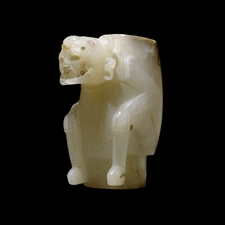<< Our Photo Pages >> Isla de Sacrificios - Ancient Temple in Mexico in Veracruz
Submitted by bat400 on Sunday, 11 March 2012 Page Views: 5948
Multi-periodSite Name: Isla de SacrificiosCountry: Mexico Region: Veracruz Type: Ancient Temple
Nearest Town: Vera Cruz
Latitude: 19.175000N Longitude: 96.092W
Condition:
| 5 | Perfect |
| 4 | Almost Perfect |
| 3 | Reasonable but with some damage |
| 2 | Ruined but still recognisable as an ancient site |
| 1 | Pretty much destroyed, possibly visible as crop marks |
| 0 | No data. |
| -1 | Completely destroyed |
| 5 | Superb |
| 4 | Good |
| 3 | Ordinary |
| 2 | Not Good |
| 1 | Awful |
| 0 | No data. |
| 5 | Can be driven to, probably with disabled access |
| 4 | Short walk on a footpath |
| 3 | Requiring a bit more of a walk |
| 2 | A long walk |
| 1 | In the middle of nowhere, a nightmare to find |
| 0 | No data. |
| 5 | co-ordinates taken by GPS or official recorded co-ordinates |
| 4 | co-ordinates scaled from a detailed map |
| 3 | co-ordinates scaled from a bad map |
| 2 | co-ordinates of the nearest village |
| 1 | co-ordinates of the nearest town |
| 0 | no data |
Internal Links:
External Links:

We found two stone buildings of good workmanship, each with a flight of steps leading up to a kind of altar, and on those altars were evil-looking idols, .... Here we found five Indians who had been sacrificed to them on that very night. Their chests had been struck open and their arms and thighs cut off, and the walls of these buildings were covered in blood. All this amazed us greatly, and we called this island the Isla de Sacrificios... - Bernal Díaz, Historia verdadera de la conquista de la Nueva España.
By 1820 only the trace of ruins could be found, but many artifacts, appearing to have ritual use, have been excavated from the site and are stored at the British Museum today. The island itself is part of a marine santcuary and is not normally accessible to the general public.
Note: Women central part of pre-colonial Maya society. See comment
You may be viewing yesterday's version of this page. To see the most up to date information please register for a free account.
Do not use the above information on other web sites or publications without permission of the contributor.
Nearby Images from Flickr






The above images may not be of the site on this page, but were taken nearby. They are loaded from Flickr so please click on them for image credits.
Click here to see more info for this site
Nearby sites
Click here to view sites on an interactive map of the areaKey: Red: member's photo, Blue: 3rd party photo, Yellow: other image, Green: no photo - please go there and take one, Grey: site destroyed
Download sites to:
KML (Google Earth)
GPX (GPS waypoints)
CSV (Garmin/Navman)
CSV (Excel)
To unlock full downloads you need to sign up as a Contributory Member. Otherwise downloads are limited to 50 sites.
Turn off the page maps and other distractions
Nearby sites listing. In the following links * = Image available
18.6km WNW 302° Zempoala* Ancient Village or Settlement
64.5km NNW 328° Quiahuiztlan* Rock Cut Tomb
97.4km WNW 296° Museo de Antropologia de Xalapa* Museum
103.8km SE 138° Tres Zapotes* Ancient Village or Settlement
114.6km SE 133° La Cobata* Sculptured Stone
154.5km WSW 239° Ndachjian-Tehuacán* Ancient Village or Settlement
181.5km WSW 251° Teteles de Santo Nombre* Ancient Village or Settlement
195.2km NW 317° El Tajin* Ancient Village or Settlement
197.6km SE 132° Cascajal Artificial Mound
211.6km SE 138° San Lorenzo Tenochtitlán Museum* Museum
216.2km SE 140° El Azuzul* Pyramid / Mastaba
232.6km W 267° Cholula* Pyramid / Mastaba
236.6km W 272° Cacaxtla* Ancient Village or Settlement
236.8km NNW 327° Tubuco Ancient Mine, Quarry or other Industry
237.2km W 272° Xochitecatl* Pyramid / Mastaba
244.2km SSW 198° Atzompa* Ancient Village or Settlement
246.4km SSW 192° Dainzu* Ancient Village or Settlement
246.8km ESE 119° La Venta.* Ancient Village or Settlement
247.5km SSW 197° Monte Alban* Ancient Village or Settlement
248.6km S 190° Lambityeco* Ancient Village or Settlement
249.4km S 189° Yagul* Ancient Village or Settlement
251.6km S 186° Mitla* Ancient Village or Settlement
256.0km SW 218° Tayata Ancient Village or Settlement
259.8km WNW 294° Huapalcalco Pyramid Pyramid / Mastaba
261.6km NW 317° Cerro del Sombrerete Rock Art
View more nearby sites and additional images



 We would like to know more about this location. Please feel free to add a brief description and any relevant information in your own language.
We would like to know more about this location. Please feel free to add a brief description and any relevant information in your own language. Wir möchten mehr über diese Stätte erfahren. Bitte zögern Sie nicht, eine kurze Beschreibung und relevante Informationen in Deutsch hinzuzufügen.
Wir möchten mehr über diese Stätte erfahren. Bitte zögern Sie nicht, eine kurze Beschreibung und relevante Informationen in Deutsch hinzuzufügen. Nous aimerions en savoir encore un peu sur les lieux. S'il vous plaît n'hesitez pas à ajouter une courte description et tous les renseignements pertinents dans votre propre langue.
Nous aimerions en savoir encore un peu sur les lieux. S'il vous plaît n'hesitez pas à ajouter une courte description et tous les renseignements pertinents dans votre propre langue. Quisieramos informarnos un poco más de las lugares. No dude en añadir una breve descripción y otros datos relevantes en su propio idioma.
Quisieramos informarnos un poco más de las lugares. No dude en añadir una breve descripción y otros datos relevantes en su propio idioma.